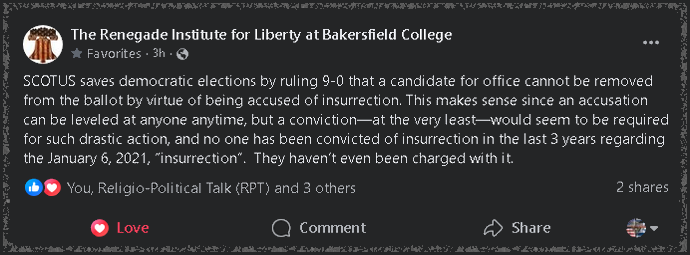Driving to Bible study this morning I got a present.
Author: Papa Giorgio

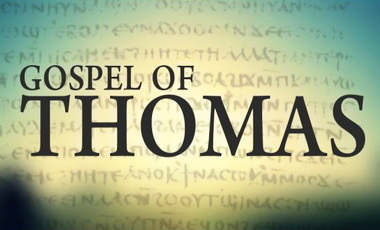
The Gospel of Thomas
The Jesus Seminar places high value on the historical basis of the Gospel of Thomas–that it recovers for us words Jesus actually spoke that are not found in our four Gospels. But many other scholars, conservatives and liberals alike, view this document more cautiously. Most think that it is no more than a second-century collection of sayings loosely based on the canonical Gospels (Matthew, Mark, Luke, and John) and other writings, and that it offers nothing that is original or older.
Craig Evans, Doubting Thomas’ Gospel, Christianity Today, June 15, 1998 Vol. 42, No. 7, Page 53 (Via APOLOGETIS INDEX)
In fact, the Jesus Seminar calls Thomas the “Fifth Gospel”. Lol. This post is being updated due to a book I am reading with some guys from church, the author stated this:
Before the gospels were written, it was easy for heretics to make up stories about the life of Christ. For example, the Book of Thomas includes fictitious stories about Jesus’ childhood, like how He would make sparrows out of clay and levitate kids who were being mean to others.
Ken Ramey, Expository Listening: A Practical Handbook for Hearing and Doing God’s Word (Woodlands, TX: Kress Biblical Resources, 2010), p.74
A couple things, I believe the author may have simply misspoke (miswrote). I do not believe the author thinks the Gospel of Thomas, what he rightly calls the “Book of Thomas,” becuase it IS NOT a Gospel as Christians understand it, predates the canonical Gospels. However, if on the off chance he does [or others do], then this is a perfect time for an update to this post. With everything I have read and watched on the matter dates to probably no earlier than A.D. 180, and is more likely in the form the Jesus Seminar lauds, closer to A.D. 220.
So if you split the difference we are looking at a reasonable A.D. 200
If Ken Ramey meant the “Gospel” of Thomas the Contender, that is even of a later date. Darrell Bock says that is dated early to mid-third century.
But here is the rest of the story.
(Via Inspiring Philosophy) This is an in-depth look into what the gospel of Thomas is and when it was written. Sources:
- Simon Gathercole – The Gospel of Thomas | NT Wright – The New Testament and the People of God | Craig Evans – Fabricating Jesus | John P. Meier – A Marginal Jew | Darrell Bock and Dan Wallace – Dethroning Jesus | Hippolytus of Rome – Refutation of all Heresies | Cyril of Jerusalem – Catechesis Lecture | Richard Bauckham – Jesus and the Eyewitnesses | Nicholas Perrin – Thomas: The Fifth Gospel?
Author and professor Darrell Bock breaks down some of the dating:
- Apocalypse of Peter—mid-second to mid-third century
- Apocryphon of James—late second to early third century
- Apocryphon of John—mid-second to early third century
- Dialogue of the Savior—mid- to late second century
- Eugnostos the Blessed—late first century to second century
- Excerpta ex Theodoto—late second century
- Gospel(s) of Bartholomew—fifth or sixth century
- Gospel of Judas—second century
- Gospel of Mary Magdalene—early to late second century
- Gospel of Peter—mid-second century
- Gospel of Philip—late second to early third century
- Gospel of the Egyptians—second to third century
- Gospel of the Savior—second century
- Gospel of Thomas—late first to early second century
- Gospel of Thomas the Contender—early to mid-third century
- Gospel of Truth—mid-second century
- Hypostasis of the Archons—third century
- Interpretation of Knowledge—mid- to late second century
- Letter to Rheginos ( =Treatise on the Resurrection)—late second century
- Pistis Sophia—second century
- Second Treatise of the Great Seth—late second century
- Sophia of Jesus Christ—second century
- Teachings of Silvanus—mid-third to early fourth century
- Treatise on the Resurrection (Letter to Rheginos)—late second century
- Tripartite Tractate—third to fourth century
- Valentinian Exposition—late second century
Darrell L. Bock, The Missing Gospels: Unearthing the Truth Behind Alternative Christianities (Nashville, TN: Nelson Book, 2006), 218-219.
I think one of the most damning disproof’s of the weight the Jesus Seminar gave to the “Gospel” of Thomas is the dating of the very first mentions of this supposed “gospel”:
When is Thomas explicitly mentioned? Thomas is referred to by Hippolytus in his Refutation of Heresies that we think should be dated around 220 A.D. Origen about ten years later in his Homilies on Luke refers to the Gospel of Thomas. Thomas is not quoted by anyone in the first and second centuries. Contrast this observation, this non-usage, with the citations of, allusions to, and explicit discussion of the four New Testament gospels. Clement, writing at the end of 95, knows the Synoptic Gospel tradition. But I will focus mostly on Papias, who wrote around 110. Papias talks about the four gospels. He knows the Gospel of Mark. For the sake of discussion let us say Mark was written in 70. I actually think it is earlier than that. In any case, Mark is written in 70, and John in about 90, and Matthew and Luke in between. So in this 20-year period of time, we have the four New Testament gospels. And within forty years of Mark, Papias is talking about Mark, or within 20 years of John, Papias is talking about John. Papias doesn’t talk about Thomas. If Thomas was produced in the 70s, how is this omission to be explained? If we accept April DeConick’s reconstruction, and assume a “kernel” of Thomas already as early as the 40s or 50s, how is this to be explained? Papias is very interested in Apostolic tradition. If there is a core of material that is supposed to represent Jesus’ teaching, and it is treasured by a group that rallies around the name of either James or later Thomas, how is this omission to be explained? Now, it’s possible Papias simply didn’t know and it got by him maybe because of the eastern origin and circulation of Thomas. But I have to wonder, how does this continue? Ignatius, writing around 180 and very concerned with gospels and gospel-like writings, doesn’t know of Thomas. Around 150 Justin Martyr harmonizes the three synoptics, not the “four” Synoptics. That is, he doesn’t harmonize Thomas. The author of papyrus Egerton, which I date to the middle of the second century, is, I believe, a harmony. We have Synoptic and Johannine elements combined. I reject the theory that it’s a mid-first century document that in its original form predates the New Testament gospels before their bifurcation into distinctive Johannine and Synoptic streams. So we have another second century harmony. Where’s Thomas? Why hasn’t Thomas material been incorporated into these gospel harmonies? We have Matthew, Mark, Luke, and John harmonized by Tatian, but not Matthew, Mark, Luke, John, and Thomas harmonized by Tatian. And this is what troubles me. I am especially troubled by Irenaeus who at length insists there are only four early, apostolic Gospels, and who mentions the other gospels produced by other groups, including the Gospel of Judas, much talked about in the public press three years ago. Yet Irenaeus doesn’t know of Thomas. How does Thomas stay under the radar for 150 years, from 70, let us say, to 220? Is it possible? Sure, lots of things are possible. It is just hard to explain that.
Craig Evans, Doubting Thomas: Is the Gospel of Thomas an Authentic Witness to Jesus?, Midwestern Journal of Theology 8.1 (Fall 2009): 3-40 [my PDF copy, pages 17-18].
WINTERY KNIGHT continues this line of counter evidence showing that there is too much of a dependence on late materials (he quotes an article found at THEREFORE GOD EXISTS):
First reason, Thomas has literary dependence on TONS of other New Testament books, which favors a date for Thomas AFTER the books it quotes:
The Gospel of Thomas Cites Too Much Of The New Testament. Publishing writings in the first century was nothing like it is today. If you want a copy of something, you take a quill and some papyrus and you just copy it. That is how the books of the New Testament circulated. It was a very slow process. By the early second century, only a few of the books of the New Testament were in full circulation. Christians of that time only had a few of the books of the New Testament to reference. The epistles of Ignatious, written in AD 110, does not even quote half of the New Testament.
But the gospel of Thomas shows familiarity with 15 of the 27 books of the New Testament! Doctor Craig Evans pointed out that he was not aware of any Christian writing which referenced this much of the New Testament prior to AD 150. The Gospel of Thomas simply references far too many books to be dated early. But despite that, the Jesus Seminar attempts to date Thomas between AD 60 and 70.
Further, this gospel not only cites too much New Testament material. It cites the later New Testament material. Mark was not very strong in Greek grammar and etiquette, so when Matthew and Luke quoted Mark, they polished his wording. The gospel of Thomas quotes the polished wording, the later version. In fact, Thomas even has material from the gospel of John – penned in about AD 90. How can a book from AD 60 or 70 quote a book from AD 90? Thomas is not independent of the other gospels, it quotes the later ones and it is not early, it quotes too much of the New Testament to be considered early.
All these resources deal with other counter evidences to an early writing/publication of this “gospel,” however, I am only sharing resources that others an more thoroughly investigate for themselves. James White states simply the two lines of evidence showing a late, “non-fifth ‘gospel'” aspect of Thomas (EQUIP.ORG):
…The large majority of scholars date The Gospel of Thomas to the middle of the second century. The reason is obvious. The religious beliefs and concepts that came into vogue after the New Testament period deeply influenced this work. Strange, esoteric doctrines and beliefs appear throughout Thomas. These teachings are not only directly contradictory to the teachings of the canonical Gospels, but they also point to a date for the production of the work well into the century after Christ. Here is a sampling of interesting statements attributed to Jesus in The Gospel of Thomas:
- “When you see one who was not born of woman, fall on your faces and worship. That one is your Father” (15).
- “If the flesh came into being because of spirit, that is a marvel, but if spirit came into being because of the body, that is a marvel of marvels. Yet I marvel at how this great wealth has come to dwell in this poverty” (29:1–3).
- “Where there are three deities, they are divine. Where there are two or one, I am with that one” (30).
- “Congratulations to those who are alone and chosen, for you will find the [Father’s] domain. For you have come from it, and will return there again….If they say to you, ‘Where have you come from?’ say to them, ‘We have come from the light, from the place where the light came into being by itself, established [itself], and appeared in their image.’ If they say to you, ‘Is it you?’ say, ‘We are its children, and we are the chosen of the living Father.’ If they ask you, ‘What is the evidence of your Father in you?’ say to them, ‘It is motion and rest’” (49–50:1–3).
- “I am the light that is over all things. I am all: from me all came forth, and to me all attained. Split a piece of wood; I am there. Lift up the stone, and you will find me there” (77:1–3).
- “How miserable is the body that depends on a body, and how miserable is the soul that depends on these two” (87).
- “Whoever drinks from my mouth will become like me; I myself shall become that person, and the hidden things will be revealed to him” (108).
- “Damn the flesh that depends on the soul. Damn the soul that depends on the flesh” (112).
The thorough influence of Gnostic concepts is found throughout these passages. Yet, despite this, the Jesus Seminar is willing only to say that Thomas reflects an “incipient gnosticism.” Admitting how thoroughly the work is soaked in Gnostic thought would place Thomas far into the second century and would show to the unbiased observer that the canonical Gospels are far superior to Thomas on any meaningful historical basis.
In addition to the plain influence of a developed Gnostic world view, the Gospel of Thomas also shows deep familiarity with the canonical Gospels, freely drawing from them. These two factors together obviously make Thomas a late and secondary work.
So why has the Jesus Seminar made such an issue of Thomas? The answer goes to the very heart of what the Jesus Seminar is all about: the re-creation of the Christian faith in a mold more pleasing to the leaders of the group (Robert Funk in particular). Funk’s dislike of confessional, historical Christian belief is easily documented in his writings. Dedicating The Five Gospels to Galileo, Thomas Jefferson (“who took scissors and paste to the gospels”), and David Strauss hardly leaves one in doubt of the viewpoint of the editors….
(emphasis added)
In similar fashion to the above information, WINTERY KNIGHT bullet points two reasons to regard Thomas as NOT part of the canonical Gospels:
- it contains gnostic overtones, and that movement started in the 2nd century
- none of the early Church Fathers quote it, but they quote the four gospels and the letters of Paul, etc.
Here again is Inspiring Philosophy dealing with some of the challenges surrounding this work:
And of course the indomitable Norman Geisler shres a bit as well:
The Gospel of Thomas Portrays a Second-Century Gnosticism. The Gospel of Thomas is influenced by the kind of Gnosticism prevalent in the second century. For instance, it puts into the mouth of Jesus these unlikely and demeaning words: “Every woman who will make herself male will enter the Kingdom of Heaven” (cited by Boyd, 118).
[….]
The Canonical Gospels Are More Historically Trustworthy. There are numerous reasons why the New Testament Gospels are more trustworthy than the Gnostic ones. First, the earliest Christians were meticulous in preserving Jesus’ words and deeds. Second, the Gospel writers were close to the eyewitnesses and pursued the facts (Luke 1:1–4). Third, there is good evidence that the Gospel writers were honest reporters […]. Fourth, the overall picture of Jesus presented in the Gospels is the same.
The Basic New Testament Canon Was Formed in the First Century. Contrary to claims of the critics, the basic New Testament canon was formed in the first century. The only books in dispute have no apologetic effect on the argument for the reliability of the historical material used to establish the deity of Christ.
[….]
The Second-Century Fathers Support the Canonical Gospels. The second-century Fathers cited a common body of books. This includes all the crucial books that support the historicity of Christ and his resurrection, namely, the Gospels, Acts, and 1 Corinthians. Clement of Roman (A.D. 95) cited the Gospels (Corinthians, 13, 42, 46). Ignatius (ca. 110–115) cited Luke 24:39 (Smyrnaeans 3). Polycarp (ca. 115) cited all the Synoptic Gospels (Philippians 2:7). The Didache often cites the Synoptic Gospels (1, 3, 8, 9, 15–16). The Epistle of Barnabas (ca. 135) cites Matthew 22:14). Papias (ca. 125–140) in the Oracles speaks of Matthew, Mark (following Peter), and John (last) who wrote Gospels. He says three times that Mark made no errors. What is more, the Fathers considered the Gospels and Paul’s epistles to be on a par with the inspired Old Testament.
Thus the Fathers vouched for the accuracy of the canonical Gospels in the early second century, well before the Gospel of Thomas was even written.
Norman L. Geisler, “Gospel of Thomas,” in Baker Encyclopedia of Christian Apologetics, Baker Reference Library (Grand Rapids, MI: Baker Books, 1999), 297–298.
Since my site is called RELIGIO-POLITIAL TALK, let me delve into a section, or saying of this supposed Jesus, that challenges those who accept it as part of Christianity. Fist, I will excerpt from a chapter in my book the high regard for women by the early church and specifically the Apostle Paul — whom feminist like to paint as “part of the patriarchy.”
Gnosticism vs. Feminism
Another reason that Christianity succeeded over that of the other ideologies of its day is partly due to – I believe – the high regard given to woman as compared to the pagan religions of the day, Gnosticism included. This topic is dealt with in the book How Christianity Changed the World, by Alvin J. Schmidt. His chapter entitled “Women Receive Freedom and Dignity” is very revealing.[1] 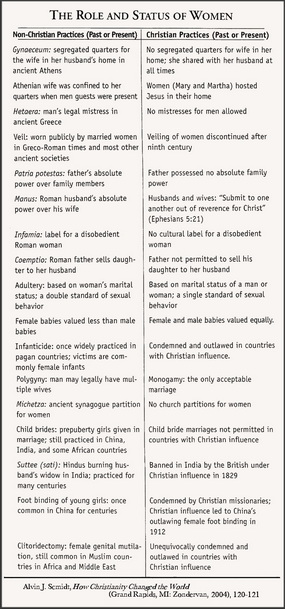
Paul, for instance, had a high regard for women as coworkers, which is amply demonstrated in other letters.[2] Barbara Geller points out that “during the Byzantine era, female leadership was exercised largely within the hierarchical structures of women’s monastic communities.” She continues, however, that,
…the letters of Paul and the Book of Acts suggest that in the earliest phase of emerging Christianity, the opportunities for women were far greater. The closing chapter of Paul’s letter to the church at Rome, following the epistolary conventions of that period, includes greetings and personal commendations. Paul mentions ten women, the first of whom is Phoebe, described in Greek as diakonos and a prostates, correctly translated in the New Revised Standard Version as “deacon” and “benefactor” (Rom 16:1-2). Older translations erroneously rendered these words as “deaconess” and “helper”; thus, generations of translators ignored the plain sense of the text because of their assumption that women could not have exercised significant roles in the early church. Ancient Inscriptions suggest, moreover, that prostates was not only a benefactor or patron, but also frequently the president or head of an association.[3]
As is common, people today with an agenda misinterpret Scripture to bolster a political position or to live comfortably within their own worldview. Paul, in his letters, interprets the role of women more liberally than his antagonists say he does. Even the Gospels portray women as being more spiritually perceptive than men.[4] So it is hardly surprising that early Christianity proved to have a deep appeal for women, as one scholar observes:
“It is probable that Jesus’ teachings attracted women in part because of the new roles and equal status they were granted in the Christian community. There were many cults in Greece and Rome that were for men only, or at best, allowed women to participate in very limited ways [as prostitutes, for instance, in the fertility cults within ‘goddism’]…. Judaism offered women proselytes a circumscribed place at best, for they were faced with the Jewish restrictions that limited participation in religious functions. While women were not allowed to make up the quorum[5] necessary to found a synagogue, nor to receive the Jewish covenant sign (circumcision), these limitations did not exist in the Christian community.”[6]
The Book of Acts is another indicator of the early church’s emphasis on the important role of women. In fact, Peter’s speech to the Pentecost crowd included portions of the Old Testament book of Joel: “And it shall come to pass in the last days, says God, that I will pour out my spirit on all flesh, your sons and your daughters will prophesy…. And on My menservants, I will pour out my Spirit in those days…” (Acts 2:17-18). In the beginnings of this new church founded by Jesus of Nazareth we find women mentioned at the very beginning of Christianity’s historical book, Acts. In 1:14 of Acts we find the disciples were constantly in prayer “along with the women and Mary the mother of Jesus.” The first convert in Philippi, for instance, was Lydia, a dealer in purple cloth (Acts 16:14). The Philippi church meets first in her home (Acts 16:40). Then Priscilla is introduced (18:2), who was a Jewish evangelist! Together with her husband, Aquila, she is mentioned four times in Acts, always being the first mentioned.[7] Likewise, In Romans 16:3 we find Paul mentioning first Priscilla and then her husband, Aquila – mentioning that both are equal in Christ: “Greet Priscilla and Aquila, my fellow workers in Christ Jesus.” In fact, Priscilla is always mentioned prior to her husband except for once, another key to the overturning of patriarchal customs up to that point.[8]
Luke makes mention of when Paul visited the evangelist Philip in Caesarea, that he had four daughters who prophesied. Far from Paul and the church being oppressive to women, this type of universality that included women was a departure from both Jewish norms as well Roman norms. The Romans in fact, could have used this early equalizing as being socially subversive to their social order, in this case to the patriarchy. Likewise, the Jewish leaders who rejected Jesus and the teachings of the early church, including Paul at first, severely restricted the role of women.[9] Paul and the other writers of the New Testament telling men that they should cherish their wives (Ephesians 5), that marriage is a financial partnership (I Timothy 5:8), that the husband is to honor his wife (I Peter 3:7), and that the male should be a part of raising their children within the family unit was essentially unheard of until then. In contradistinction, the Gospel of Thomas “is clearly influenced by the kind of Gnosticism we know was prevalent in the second and third centuries, but not in the first.”[10] For example, we find Jesus of the Gospel of Thomas responding to Peter, let’s read:
- (Saying # 114): Simon Peter said to them, “Let Mary leave us, for women are not worthy of life.” Jesus said, “I myself shall lead her in order to make her male, so that she too may become a living spirit resembling you males. For every woman who will make herself male will enter the kingdom of heaven.”
“This demeaning view of women was common within Gnosticism, but utterly foreign to the historical Jesus.”[11] The fact that the canonical Gospels were written a century or two earlier than those of Gnosticism is at least a good preliminary indication that they could possibly also be more authoritative. O. C. Edwards agrees:
“It is precisely as history that I find her [Pagels] work most unsatisfactory. Nowhere, for instance, does she give the impression that the basic picture of Jesus given in the New Testament gospels did not arise contemporaneously with the Gnostic portrait, but antedated it by at least a century. As historical reconstructions [go,] there is no way that the two can claim equal credentials.”[12]
To ignore the century before Gnosticism started, seems to me, like a tell in poker. That is when the opposing player does something or makes an odd move to show the other players that he or she is bluffing, verbal or not. In this case, the total disregard for pre-Gnostic history and roots is telling.
[1] The following list, “The Role and Status of Women” (Grand Rapids, MI: Zondervan, 2004), 120-121.
[2] Dale & Sandy Larsen, 7 Myths about Christianity (Wheaton, IL: InterVarsity Press, 1998), see chpt. 2, “Christianity Suppresses Women”; also all one has to do is read 1 Corinthinas 7:1-16, here Paul puts the male and female on equal terms and status, unheard of in the ancient pagan world… until that is, the New Testament and the Christian community. In fact, Wayne Grudem makes this new distinction apparent when he points out the role of women in the early church:
Perhaps the best example of a woman well trained in knowledge of the Bible is Priscilla. When Paul went to Corinth, he stayed with Aquila and Priscilla: “because he was of the same trade he stayed with them and worked, for they were tentmakers by trade” (Acts 18:3). Paul stayed a year and six months at Corinth (Acts 18:11), and we may ponder just how much Bible and theology Priscilla would have learned while having the apostle Paul as a house guest and business partner during that time! Then Priscilla and Aquila went with Paul to Ephesus (Acts 18:1819). It was at Ephesus in A.D. 51 that Priscilla and Aquila together “explained” to Apollos “the way of God more accurately” (Acts 18:26). So in A.D. 51 Priscilla knew Scripture well enough to help instruct Apollos. After that, Priscilla probably learned from Paul for another three years while he stayed at Ephesus teaching “the whole counsel of God” (Acts 20:27; compare 1 Cor. 16:19, where Priscilla is called Prisca, and Paul sends greetings to Corinth from Aquila and Prisca and the church that meets “in their house”). By the end of Paul’s three-year stay in Ephesus, Priscilla bad probably received four and a half years of teaching directly from the apostle Paul. No doubt many other women in Ephesus also learned from Paul—and from Priscilla! Aquila and Priscilla went to Rome sometime later (Rom. 16:3, perhaps around A.D. 58), but they returned to Ephesus, for they were in Ephesus again at the end of Paul’s life (in 2 Tim. 4:19, Paul writes to Timothy at Ephesus, “Greet Prisca and Aquila”). Now, 2 Timothy was probably written in A.D. 66 or 67 (Eusebius says that Paul died in A.D. 67), and 1 Timothy a short time before that, perhaps in A.D. 65. In addition, before he wrote 1 Timothy, Paul seems to have been in Ephesus and it seems he had told Timothy to remain there when he left for Macedonia (see 1 Tim. 1:3: “As I urged you when I was going to Macedonia, remain at Ephesus . . .”). Therefore, both because 1 Timothy is near in time to 2 Timothy, and because Paul had recently been in Ephesus to know who was there before he wrote 1 Timothy or 2 Timothy, it seems likely that Aquila and Priscilla were back in Ephesus by the time Paul wrote 1 Timothy, about A.D. 65. This was fourteen years after Priscilla and Aquila had explained the way of God to Apollos in Ephesus.
Evangelical Feminism: A New Path to Liberalism (Wheaton, IL: Crossway Books, 2006), 175-176.
[3] Michael D. Coogan, ed., The Oxford History of the Biblical World (2001 paperback edition; New York, NY: Oxford University Press, 1998), 429-430.
[4] Compare Mark 4:40 and 6:52 to Mark 5:25-30. See also Mark 7:24-30 and 12:41-44.
[5] “The number of members of a group or organization required to be present to transact business legally, usually a majority.” Random House Webster’s Unabridged CD-ROM Dictionary, (1999).
[6] Ben Witherington, Women and the Genesis of Christianity (New York, NY: Cambridge University Press, 1990), 246. For those who are not familiar with the Gospel and assume this to reference female circumcision, it does not. Just a quick perusal of Colossians shows that there is freedom found in Christ (Colossians 2:9-15; 3:11-12, NIV):
For in Christ all the fullness of the Deity lives in bodily form, and you have been given fullness in Christ, who is the head over every power and authority. In him you were also circumcised, in the putting off of the sinful nature, not with a circumcision done by the hands of men but with the circumcision done by Christ, having been buried with him in baptism and raised with him through your faith in the power of God, who raised him from the dead. When you were dead in your sins and in the uncircumcision of your sinful nature, God made you alive with Christ. He forgave us all our sins, having canceled the written code, with its regulations, that was against us and that stood opposed to us; he took it away, nailing it to the cross. And having disarmed the powers and authorities, he made a public spectacle of them, triumphing over them by the cross…. Here there is no Greek or Jew, circumcised or uncircumcised, barbarian, Scythian, slave or free, but Christ is all, and is in all. Therefore, as God’s chosen people, holy and dearly loved, clothe yourselves with compassion, kindness, humility, gentleness and patience.
Circumcision was not a sign of salvation or status. We are set free to love and live for Christ Jesus. Freedom is a wonderful thing, both spiritually and economically, and this is the point, modern-day feminism lacks the understanding for both, as we shall see.
[7] John W. Mauck, Paul on Trial: The Book of Acts as a Defense of Christianity (Nashville, TN: Thomas Nelson, 2001), 56.
[8] Acts 18:2, 18, 19, 26; Romans 16:3; 2 Timothy 4:19.
[9] Mauck, Paul on Trial, 56.
[10] Gregory A. Boyd, Jesus Under Siege (Wheaton, IL: Victor Books, 1995), 118.
[11] Ibid., 118.
[12] O. C. Edwards, “A Surprising View of Gnosticism,” New Review of Books and Religion, May 1980, 27. Quoted in, Gary R. Habermas, The Historical Jesus: Ancient Evidence for the Life of Christ (Joplin, MS: College Press, 1996), 107.
END OF EXCERPT
CARM has a good post of comparison of doctrine from the “Gospel” of Thomas and the Bible. Here is the relevant section:
| TOPIC: View of Women |
GOSPEL OF THOMAS: Strongly anti-feminine (114) |
BIBLE: Pro-feminine (Gospel of Mark). |
What a wonderfukl God we have, and instruction manual He has given us! CROSS EXAMINED has a decent telling of what it mans for a book to be considered to be part of the canon. My own post goes a long way to build the foundation for what should and should not be included in the Bible:
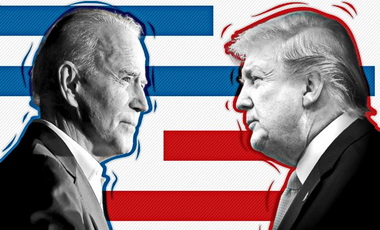
Election 2024: of Coalitions and Crumbling Lawfare Tactics
According to recent polling, because of the former president’s term in office and the bona fides of the America First agenda, the Trump coalition may very well be expanding right before our eyes. Against Mr. Biden, Mr. Trump is attracting the support of 51% of voters under the age of 30, 48% of the Hispanic vote, and 28% of the African American vote. These numbers pose a mortal threat to Mr. Biden’s wobbly candidacy. (WASHINGTON TIMES)
Alex Marlow and Steve Hilton were on FOX BUSINESS to discuss President Trumps excelling in the polls. This is with a hat-tip to BREITBART.
The below is a bonus and shows how this coalition spoken to above and the crumbling “lawfare” route the Democrts were banking on may produce a hearty win for Trump in 2024:
This is the first 19-minutes of BANNON’S WAR ROOM (3/16/2024 Episode 3467). If the trend holds that their “lawfare tactic” continues to erode, then trying to present winning ideas is also most probably an abject failure as well. Since no real accomplishments exist.
Again, good news if this trajectory holds.

Nathan Wade’s Testimony Found False, What About Willis’?
- “What I don’t understand is how the court can find that she [Willis] did act improperly in her public statements. He shreds the testimonies, he strongly indicates that he did not believe Mr. Wade, but then he ignores the fact that they testified largely in tandem. Willis adopted his testimony, she supported his testimony. So, if he was false, she was false. And it’s very hard to separate these conjoined twins. It takes quite a surgeon.” — Jonathan Turley, via DAILY CALLER
- “It really is an astonishing opinion in its disconnect because he clearly did not believe Nathan Wade and many people believe Nathan Wade committed perjury,” Turley said. “But these two essentially testified in tandem – she [Fani Willis] adopted his testimony. So if he lied, then she pretty much lied the same way. They both maintained that the relationship began after he was hired and really held a sort of unified front. I think that what the judge was trying to do in giving these two options to Wade was to gently give a third option to Willis. And that option is to remove yourself, take the ethical course. And I think that’s very clear in his opinion. Nobody reading this opinion with these damning findings could possibly believe that Willis can continue to be part of this case,” Turley continued. “She’s prosecuting people for the underlying conduct she’s accused of committing with Nathan Wade – false statements given to a court, false filings that have been submitted. How could she possibly continue that without damaging her case? But the problem is that she’s had this opportunity to take the high road, repeatedly. She clearly has never wanted to do that, and this will probably be her last chance to do the right thing and remove herself.” — Jonathan Turley, via DAILY CALLER
THE NATIONAL PULSE may have broken a story that would allow the Judge to take the “option is to remove himself, and take the ethical course.” [Adapted from Turley]:
Judge Scott McAfee, who ruled on Thursday that Fulton County District Attorney Fani Willis can continue prosecuting her RICO case against Donald Trump, donated to her in 2020.
[….]
McAfee ruled she can remain on the case despite the “appearance of impropriety,” however, as long as Wade is dismissed. There was a widespread expectation she would not receive such a favorable ruling, considering the evidence that emerged during the hearings. The fact that McAfee previously donated $150 to Willis in 2020 — the year she was elected — is now being flagged as a possible conflict of interest.
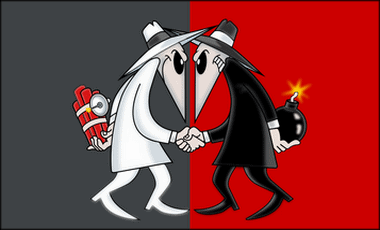
Chris Cuomo vs. Candice Owens | Non-Sequitur Galore
On the Patrick Ben-David Podcast, Chris Cuomo fails to grasp Candice Owens main point, which was that if you compare Joe Biden to any world leader [the most recent example she used was of Tucker Carlson’s interview with dictator Vladimir Putin] in a side-by-side speaking comparison, you will notice a stark difference. Cuomo merely rejects that argument by making a wholly unrelated assumption about what Candice was saying. And taking his totally unrelated interpretation and putting it forward as if it were a cogent response to Candice. But even that misrepresented response by Cuomo – if – put side-by-side with Biden, would make Biden look like a preschooler.

John F. Kennedy Would Not Recognize Today`s Democratic Party
UPDATED AGAIN w/RFK Jr. @ Bottom (Originally posted in Nov 2013)
- On racial preferences, JFK, in 1963, said he opposed them: “I don’t think that is the generally held view, at least as I understand it, of the Negro community, that there is some compensation due for the lost years, particularly in the field of education.
- On tax cuts, in a 1962 speech Kennedy said: “It is a paradoxical truth that tax rates are too high today and tax revenues are too low, and the soundest way to raise the revenues in the long run is to cut the rates now. … The purpose of cutting taxes now is not to incur a budget deficit but to achieve the more prosperous, expanding economy, which can bring a budget surplus.”
- On dealing with foreign enemies, JFK believed, as Reagan did, in peace through strength, not strength through peace. In his inaugural address, Kennedy said, “Let every nation know, whether it wishes us well or ill, that we shall pay any price, bear any burden, meet any hardship, support any friend, oppose any foe to assure the survival and the success of liberty.”
- On the Second Amendment, this lifetime member of the NRA believed it conferred an individual right to keep and bear arms. In 1961, Kennedy said: “Today we need a nation of minutemen: citizens who are not only prepared to take up arms, but citizens who regard the preservation of freedom as a basic purpose of their daily life and who are willing to consciously work and sacrifice for that freedom. The cause of liberty, the cause of America, cannot succeed with any lesser effort.”
- Abortion was not an issue during the 1960 presidential campaign. Nor was it an issue during his presidency. Kennedy did say this: “Now, on the question of limiting population: As you know, the Japanese have been doing it very vigorously, through abortion, which I think would be repugnant to all Americans.”
What Dennis Prager was asking James Swanson (audio below) was “what about the newer understanding that JFK was conservative?” (Prager has always echoed Reagan’s statement: “I didn’t leave the Democratic Party. The party left me.” This fresh look at history supports this long held belief by many ex-Dems.) When historians go through Kennedy’s speeches and candid confessions, as well as policy, they are more-and-more coming to the following conclusion:
A short excerpt from an article by Ira Stoll, in the October 2013 edition of THE AMERICAN SPECTATOR, (In case you bump into a subscriber wall, here is the entire article for free: GOP Briefing Room”)
….WHAT I TAKE to be the truth about John Kennedy and his conservatism has, in the years since he died, been forgotten. This is partly because of the work of liberal historians and partly due to changes in America’s major political parties. Yet calling Kennedy a conservative was hardly controversial during his lifetime. “A Kennedy Runs for Congress: The Boston-bred scion of a former ambassador is a fighting-Irish conservative,” Look headlined an article in June 1946. “When young, wealthy and conservative John Fitzgerald Kennedy announced for Congress, many people wondered why,” the story began. “Hardly a liberal even by his own standards, Kennedy is mainly concerned by what appears to him as the coming struggle between collectivism and capitalism. In speech after speech he charges his audience ‘to battle for the old ideas with the same enthusiasm that people have for new ideas.’”
The Chicago Tribune reported Kennedy’s election to the U.S. Senate in 1952 by describing him as a “fighting conservative.” In a June 1953 Saturday Evening Post article, Kennedy said, “I’d be very happy to tell them I’m not a liberal at all,” adding, speaking of liberals, “I’m not comfortable with those people.” In 1958, Eleanor Roosevelt was asked in a television interview what she would do if she had to choose between a “conservative Democrat like Kennedy and a liberal Republican [like] Rockefeller.” She said she would do all she possibly could to make sure the Democrats did not nominate a candidate like Kennedy.
On the campaign trail before the 1960 election, Kennedy spoke about economics: “We should seek a balanced budget over the course of the business cycle with surpluses during good times more than offsetting the deficits which may be incurred during slumps. I submit that this is not a radical fiscal policy. It is a conservative policy.” This wasn’t just campaign rhetoric—Kennedy kept his distance from liberalism right up until his assassination. “Why are some ‘liberals’ cool to the Kennedy Administration?” Newsweek asked in April 1962. The article went on to explain: “the liberal credentials of young Senator Kennedy never were impeccable…He never was really one of the visceral liberals…many liberal thinkers never felt close to him.”
Even after Kennedy’s death, the “conservative” label was used to describe the late president and his policies by some of those who knew him best. One campaign staffer and congressional aide, William Sutton, described Kennedy’s political stance in the 1946 campaign as “almost ultraconservative.” “He was more conservative than anything else,” said a Navy friend of Kennedy’s, James Reed, who went on to serve Kennedy’s assistant Treasury secretary and who had talked for “many hours” with the young Kennedy about fiscal and economic matters. Another of Kennedy’s friends, the Washington columnist Joseph Alsop, echoed these sentiments in a 1964 interview:
The thing that’s very important to remember about the president was that he was not, in the most marked way, he was not a member of the modern, Democratic, liberal group. He had real—contempt I’m afraid is the right word—for the members of that group in the Senate, or most of them…What he disliked—and here again we’ve often talked about it—was the sort of posturing, attitude-striking, never getting anything done liberalism…This viewpoint was completely foreign to Kennedy, and he regarded it with genuine contempt. Genuine contempt. He really was—contemptuous is the right word for it. He was contemptuous of that attitude in American life.
Alsop went on to emphasize “the great success that the Kennedy administration had with an intelligent, active, but (in my opinion) conservative fiscal-economic policy.”
In January 1981, in the early days of the Reagan presidency, a group of Kennedy administration veterans gathered at the John F. Kennedy Library in Boston for a private conversation. One of the participants, Ted Sorensen, said, “Kennedy was a fiscal conservative. Most of us and the press and historians have, for one reason or another, treated Kennedy as being much more liberal than he so regarded himself at the time…In fiscal matters, he was extremely conservative, very cautious about the size of the budget.” Sorensen made a similar point in a November 1983 Newsweek article, saying, “He never identified himself as a liberal…On fiscal matters he was more conservative than any president we’ve had since.” In a 1993 speech, Kennedy’s Treasury secretary, Douglas Dillon, described the president as “financially conservative.” Combine that position with hawkish anticommunism, and it is hard to find much overlap with liberals
[….]
Article will continue after
dealing with the Left’s latest lunacy…
The Left recently said JFK was killed by Right Wing or Conservative ideals. This is laughable!
REASON.COM has a great short blurb to set the record straight:
Over at the Volokh Conspiracy, David Bernstein asks the obvious question after reading various attempts to blame the assassination of John F. Kennedy on a generalized “atmosphere of hate” pervading Dallas, Texas in the early 1960s. Was Dallas a hotbed of right-wing paranoid fantasies back then? Sure was. But—and this is really kinda important—it wasn’t the likes of nutjub Gen. Edwin Walker who plugged the president. It was Lee Harvey Oswald, a Castro supporter who had defected to the Soviet Union out of a mix of Marxist idealism and anti-Americanism.
Look, guys. Lee Harvey Oswald murdered JFK. Oswald was a Communist. Not a small c, “all we are saying is give peace a chance and let’s support Negro civil rights” kind of Communist, but someone so committed to the cause (and so blind to the nature of the USSR) that he actually went to live in the Soviet Union. And when that didn’t work out, Oswald became a great admirer of Castro. He apparently would have gone to live in Cuba before the assassination if the Cubans would have had him. Before assassinating Kennedy, Oswald tried to kill a retired right-wing general. As near as we can tell, he targeted Kennedy in revenge for Kennedy’s anti-Castro actions.
DAILY SIGNAL has an excellent commentary dealing with this rewriting [literally] of history, but here is Rush Limbaugh’s short take:
A little pop quiz. What do you call a politician who is pro-life? What do you call a politician who is for lower taxes? What do you call a politician who is for a strong national defense? What do you call a president who is a proud nationalist, proud to be an American? What do you call that person?
That is John Fitzgerald Kennedy. That is who JFK was. And that is the second attempted Drive-By Media Democrat Party distraction today. Although there’s a little bit more justification for spending time on the 50th anniversary of that assassination than there is on this nuclear option business. Let me tell you how ridiculous this is getting. You and I all know, Warren report, whatever, we all know that Lee Harvey Oswald killed Kennedy. (interruption) I know. I can hear right now people throwing things at the radio, shouting things at the radio. We know that Lee Harvey Oswald fired on the president, okay? We know this, and we know what about Lee Harvey Oswald?
Lee Harvey Oswald was a communist. We know that a leftist, a communist assassinated JFK. That is the official Warren report conclusion. And yet the media cannot let go of the fact that because there were a lot of white Republican businessmen in Dallas, that it was a climate of hate, a climate of fear, a climate of extremism in Dallas that led to Kennedy’s death. Every conspiracy theory that you have heard that makes you think Lee Harvey Oswald was not the assassin was started by the Democrats. Every one.
…The American Spectator continues:
[….]
THE QUESTION OF Kennedy’s ultimate political convictions is more than a matter of mere historical curiosity. Kennedy consistently ranks near the top of public polls asking about the greatness of past presidents. His popularity suggests that the American people think his record is a model worth emulating. Simply to ape Kennedy would be impossible, of course. The Soviet Union is gone, tax rates now are lower than when Kennedy wanted to cut them, and the state universities of the South have been racially integrated. But if the contours of the foreign policy, tax, and education fights have shifted, Kennedy’s course in them may nonetheless inform our choices today, as it has since his death. And other issues of Kennedy’s time are still with us, including economic growth, government spending, inflation, and, as he put it, “Christian morality,” the “cynical philosophy of many of our intellectuals,” and “the right of the individual against the state.”
Calling Kennedy a political conservative may make liberals uncomfortable—perish the thought!—by crowning conservatism with the halo of Camelot. And it could make conservatives uncomfortable too. Many have long despised the entire Kennedy family, especially John’s younger brother Ted. But conservatives need not always trust received wisdom, especially when it comes to conservatism. Better, then, to forge ahead, to try to understand both the 29-year-old Navy veteran speaking at Faneuil Hall and the president he became.
UPDATE:
Robert F. Kennedy Jr.: “How I See The State Of Our Union” (Response to Joe Biden’s SOTU speech):
- “Neither my uncle nor my father would recognize the version of America that we have today. We’ve become a nation of chronic illness, of violence, of loneliness, depression and division and poverty.”
A lot of the stats he references have good answers, however, the reason for this is that he is speaking in the vain of thee Democrat Party his father led. Not the LBJ party. That said, know this is a campaign video.

“Professionals Know Best” Admit To Ruining Children’s Lives
Reality is a bitch! And even those involved in the delusion of thinking one can change sexes in people struggling with internal issues as deep as thinking they can be something they are not. JUST THE NEWS has this article n papers and conversations regarding this attempt to fix an issue that makes the matter worse. This is the subtitle to the article:
- World Professional Association for Transgender Health members swap candid stories, seek advice in private forum, panel discussion. Testosterone wreaks havoc on women’s bodies over time. WPATH dismisses “scare tactics.”
So what is the main idea herein? JTN starts out with the breakdown:
- A tranche of internal discussions among leaders and practitioners in the so-called gender-affirming-care industry stands to amplify concerns about the safety and effectiveness of puberty blockers, cross-sex hormones and genital surgeries on children with gender dysphoria.
Michael Shellenberger
Michael Shellenberger quickly explains these files and why he is publishing them (see his Twitter/X “THREAD“):
Why I Am Publishing WPATH Files And How I Got Them
The written WPATH Files come from WPATH’s member discussion forum, which runs on software provided by DocMatter.
Ninety seconds of the 82-minute video was made public last year. We are making the full video available for the… pic.twitter.com/3AP0pVUTxy
— Michael Shellenberger (@shellenberger) March 4, 2024
Of course we all know/knew this, but here is more professional and candid conversation by those pushing the idea and their seeing the wasteland they are making [reality] and trying to rationalize their choices. (The video below the article excerpts talks about this delusion, the time put into this “venture” [child abuse] and trying to continue the rationalization that they were “on the side of the angels”.) I mean, we are talking about double mastectomies on 12 and 13-year old females with perfectly healthy breasts. And politicians lie about it.
Take for instance Jamie Reed, someone dedicated to the task at hand, hitting the rough road of reality (NEW YORK POST),
In a stunning condemnation, Jamie Reed, 42, a former case manager at the Washington University Transgender Center at St. Louis Children’s Hospital, said she quit in November after four years “because I could no longer participate in what was happening there.”
“What is happening … is morally and medically appalling,” the whistleblower warned Thursday in a piece for The Free Press.
According to Reed — who describes herself as a queer “progressive” and married to a “trans man” — soon after she started working at the pediatric gender clinic, she was “struck by the lack of formal protocols for treatment,” leaving physician co-directors as the “sole authority.”
She said little was needed for kids to begin transitioning — a letter of support from a therapist “who they had to see only once or twice for the green light,” and a single visit for girls to an endocrinologist for a testosterone prescription. ….
(NEW YORK POST | An entire EPOCH TIMES interview with Jamie can be see HERE)
See more on this via The Federalist: “Boston Children’s Hospital Touts Hysterectomies And Other Mutilation For ‘Trans’ Minors“
So… back to the JUST THE NEWS article…
A tranche of internal discussions …
…. [that] show members of the World Professional Association for Transgender Health admitting that some young patients or colleagues developed life-threatening medical conditions or even died after years of treatment.
These are more serious than the sexual dysfunction and developmental problems, such as sterilization, inability to orgasm, weaker bones and sudden spikes in brain pressure, already reflected in research and even federal guidance on gender affirming care.
“The WPATH Files” came from “one or more” people with access to the organization’s member discussion forum, whose conversations confirm that “transgender medicine is neither scientific nor medical,” Twitter Files journalist and contrarian environmentalist Michael Shellenberger wrote in a lengthy X thread Monday night.
Shellenberger’s Environmental Progress research group summarized and posted the leaked communications, which appear to have been copied from printouts based on the skewed orientation, squished spacing and degradation of forum pages.
“WPATH serves no purpose, contributes nothing beneficial to the field of gender medicine, and leads medical and mental health professionals astray,” says the report, written by journalist Mia Hughes. “Several European nations have already abandoned the group’s guidelines, indicating the extent to which WPATH has become obsolete.”
A 16-year-old patient developed “two liver masses” after several years on a menstrual-suppression drug and one year of testosterone, “and the oncologist and surgeon both have indicated that the likely offending agent(s) are the hormones,” a doctor wrote in the forum.
Another responded that a female colleague who identified as a man died of liver cancer, which “[t]o the best of my knowledge … was linked” to taking testosterone for nearly a decade.
Three years of testosterone gave a young woman pelvic inflammatory disease, with vaginal atrophy typical of postmenopausal women and “a persistent yellow discharge we often see as a result” of treatment, a nurse practitioner wrote. Hughes said PID’s fatal risks include ectopic pregnancy and “spread of infection to other body parts.”
The report states the names of members were redacted “except in the case of the WPATH president, surgeons, and other prominent members” and did not edit the files.
Only one WPATH member answered a request for comment, with “legal threats,” and an email obtained by Environmental Progress showed “WPATH advising against replying and informing the recipients that WPATH was seeking legal counsel,” the report says.
“WPATH is and has always been a science- and evidence-based organization whose recommendations are widely endorsed by major medical organizations around the world,” President Marci Bowers said in a statement the group gave Just the News.
“We are the professionals who best know the medical needs of trans and gender diverse individuals – and stand opposed to individuals who misrepresent and de-legitimize the diverse identities and complex needs of this population through scare tactics,” Bowers wrote. ……….
All this leads me to this excellent discussion about what was revealed by this WPATH admissions and the coming fallout. The opening and detailing of past medical hype and women and others who just went along professionals who best know is eye-opening:
Join Genspect and FAIR in Medicine to discuss the WPATH Files Report with Stella O’Malley, Carrie Mendoza, MD, and Mia Hughes, the report’s author from Michael Shellenberger’s Environmental Progress. What are the key insights from the report and leaked documents? What have we learned about WPATH’s public versus private culture? How will this information impact advocacy moving forward? Join us for the first in a series of webinars about the WPATH Files from Genspect and FAIR in Medicine.
RELATED:
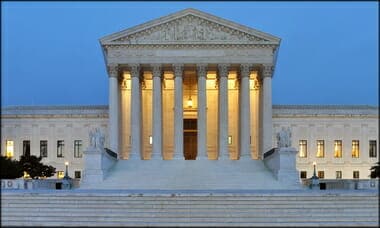
RPT SCOTUS Prediction: 9-0 or 8-1
So at 8:20 AM (Feb 8th, 2024) I said this on my Facebook:
- Listening to the SCOTUS hearing on the 14th Amendment challenge. I think it may be a 9-0 decision. Maybe an 8-1?
UPDATE!
The rest of the original post….
Here is some later discussion of this:
‘Parade Of Horribles’: Johnathan Turley Skewers Colorado Lawyer After SCOTUS Ballot Hearing on Thursday

RPT Primary Voter Guide (March 5th, 2024)
Here are my resources used for this March 5th Primary.
- JOHN AND KEN’S Voter Guide to the 2024 Primary election
- HOWARD JARVIS TAXPAYERS ASSOCIATION 2024 (California Initiatives)
- GOP Voter Guide (for my area)
- California Republican Assembly
- ELECTION FORUM’S L.A. Voter Guide
- Los Angeles County and Superior Court JUDGE VOTER GUIDE
- Santa Clarita Valley Republican Women
Here is my – just in the nick of time – voter guide:
VOTER GUIDE
Download and print the one-page PDF
CITY/LOCAL
State Senator 23rd District: James “DJ” Hamburger
Member of the State Assembly, 40th District: Patrick Lee Gibson
United States Representative 27th District: Mike Garcia
COUNTY
Supervisor 5th District: Kathryn Barger
District Attorney: David S. Milton
JUDGES JUDGE OF SUPERIOR COURT OFFICE
#12: Lynn Diane Olson
#39: Steve Napolitano
#48: Renee Rose
#93: Victor Avila
#97: Sam Abourched
#115: Keith Koyano
#124: Emily Theresa Spear
#130: Osman M. Tahir
#135: Mohammad Ali Fakhreddine
# 137: Tracy M. Blount
Member County Central Committee, 40th Assembly District :
(Any 7 Republicans will do, but these are my seven):
Nune Gipson | Veronica Hixon | Aakash Ahuja | Melissa Lundie | Denise Lite | Lucie Volotzky | Joe Messina
STATE
Measure 1: NO!
NATIONAL ELECTION
Presidential Preference: Donald J. Trump
United States Senator: Steve Garvey [temp as well]

Google Gemini AI Story Gets Worse | Matt Walsh
Today on the Matt Walsh Show, you might think the story of Google’s woke dystopian AI program can’t get any worse, but it has. I’ll explain. Also, the media claims that conservatives at CPAC are plotting the end of democracy. A pundit on MSNBC inadvertently claims that America is a fundamentally christian nationalist country. The Left freaks out after a court in Alabama grants personhood rights to human embryos. And Kristen Stewart is on a press tour and she really wants you to know that she’s gay. Why do we need to know this? and why is she wearing a mullet?

SAFETY TIP: How To Stop a Dog Attack/Fight 101
I combined three of the best videos I have come across over the years to give you a working tactic to stop a dog fight or attack. It is a good skill to have in your wheelhouse.
Here are the original files used, in order of appearance:

Leaves from a Russian Diary | Pitirim Sorokin
The original file is here, via Voices of the Past — they have great stuff, go heck their channel out. I just posted on Mr. Sorokin earlier today, This will be a separate post from that.
Here is a small clip regarding
Sorokin’s enthusiasm for the Revolution was quickly tempered, however, by the widespread outbreak of uncontrolled homicidal violence from many quarters which followed the collapse of Tsarist rule. The ruthlessness, fanaticism, and calculated cruelty displayed by Lenin and the Bolsheviks were particularly unsettling to Sorokin since, like a tornado, it seemed to sweep up everything in its course. By the end of 1917, less than a year after the overthrow of the Tsar, Sorokin had clearly become disillusioned with political revolution and expressed this disillusionment in a particularly poignant entry in his diary:
This is the last day of 1917. I look back on the year with feelings of bitterness and disillusionment. The year 1917 gave us the Revolution, but what has Revolution brought to my country but ruin and disgrace? Has it brought us freedom? Has it bettered the condition of the people? No, the face of revolution unveiled is the face of a beast, of a vicious and wicked prostitute, not that of the pure goddess which has been painted by historians of other revolutions. I could pray that these historians themselves might live through a real revolution. (LRD 112)
His active opposition to the Bolsheviks led to his imprisonment in early 1918, though with the help of his wife Elena and a sympathetic benefactor he was released from jail after a two-month stay. Soon after his release, however, he resumed his opposition to Bolshevism and took part in an abortive attempt to liberate northern Russia from Bolshevik rule. He was later hunted down and finally surrendered to the pursuing Communist Cheka, whereupon he was thrown into a Bolshevik prison for the second time and informed that he would soon be executed. This confrontation with death had a lasting impression upon him and seems to be partially responsible for the later rekindling of his earlier Christian spirituality and his later emphasis on the central need in human affairs for the healing and reconciling power of agapic love. Sorokin was saved from the firing squad only by virtue of the intersession of two of his former university friends—both Communists who had gone on to assume important positions in Lenin’s cabinet. Lenin himself issued the order to spare Sorokin, though only after having written an article in Pravda that held Sorokin up as a model of the futility of any kind of centrist position between the Communists and the pro-tsarist reactionaries. (Sorokin’s two brothers, however, were not so fortunate—both of them eventually perished in clashes with the Bolshevik regime.)
Sorokin had correctly perceived the nature of Bolshevism from the very beginning, and unlike many Western intellectuals who had to await the revelations of Khrushchev’s 1956 “Secret Speech” or Solzhenitsyn’s Gulag Archipelago, he harbored no illusions that ruthless men in power would bring about a socialist utopia. ….



